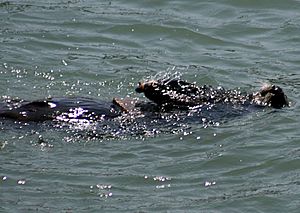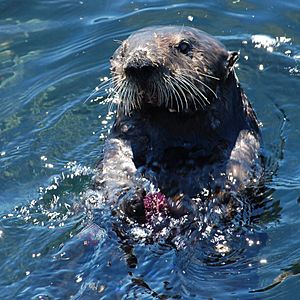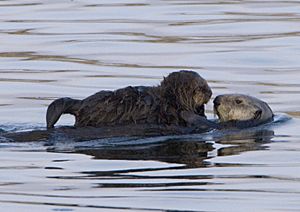Tool use by sea otters facts for kids
The sea otter is a special type of marine mammal that lives entirely in the water. They are part of the weasel family, called Mustelidae. Sea otters are the smallest marine mammals, but they are also very clever with their paws. They are famous for using stones like tiny anvils or hammers to open hard-to-reach food. Many types of otters use stones, which suggests they might be born with a natural ability to do this.
Sea otters often use rocks to crack open shells. They also rip open food with their front paws. When floating on their backs, otters will tear apart coral algae to find food hidden inside. How often they use tools can be different for each otter and where they live. But using tools is a normal part of a sea otter's life when it helps them get food.
Contents
How Sea Otters Started Using Tools
Why Otters Use Tools
We don't know exactly when sea otters first started using tools regularly. Scientists think that certain behaviors helped them survive and became more common over time. Maybe an otter once couldn't get a tasty treat from the ocean floor. It might have used a rock to help reach it. Or, an otter on its back might have tried to crush two clams together when its paws or teeth weren't strong enough.
Shellfish often live on rocks at the bottom of the ocean. So, otters might have learned to collect rocks and shellfish. Then, they would crush them together on the surface. If a new behavior helped an otter get food, it might try it again. This is how they could have learned to use tools often.
Sea otters often swim and eat while floating on their backs. This position helps them use tools. Even otters that don't use tools still eat on their backs. This flat surface on their chest is perfect for holding rocks and pounding food. Once a few otters started using tools, others nearby might have learned by watching them.
Baby otters stay very close to their mothers. A mother otter usually has one pup at a time. Pups depend on their mothers for about 6 to 7 months. Very young pups can't swim or dive well because of their special baby fur. So, they must stay with their mothers all the time. This means mother otters give their pups a lot of attention for a long time.
Young otters are also very active, curious, and playful. Playing with objects might have helped them learn to use tools later on.
Body Changes for Tool Use
Sea otters are part of the group called Carnivora. Most carnivores have sharp, blade-like teeth for cutting meat. But sea otters have different teeth. Their back teeth are flat and rounded, which helps them crush food. These teeth are great for eating sea creatures with hard shells, which is important for otters living in the water.
Compared to other animals in the weasel family, sea otters have special back legs. These legs help them move and stay steady on the water's surface. This allows their front paws to be free to use tools and handle food. Sea otters have strong muscles in their hindquarters.
A sea otter's front paws are small and not used for swimming. But their front paws are perfect for feeling things, handling food, and using tools.
Sea Otter Anatomy
A sea otter's lower front teeth stick out a bit and are shaped like small shovels. This helps them scoop food out of shellfish. When eating sea urchins, otters use a tool or their paws to crack them open. Then, they use their lower front teeth to scoop out the soft parts. Their canine teeth are blunt, and their back teeth are flat. This shape is good for chewing soft sea creatures and hard shell pieces.
Sea otters also have some of the biggest lungs in the otter family. This helps them float easily, especially since they don't have blubber (a thick layer of fat). Floating well allows otters to lie on their backs and handle food, tools, and even their babies while on the water's surface.
Underneath each sea otter's arm, there's a loose flap of skin. This pouch can store stones and food. Their back legs are long and flat like flippers. Their tail is also flat and moves in a wavy way to help them swim. Their paws and whiskers work together to find and grab food underwater.
How Otters Learn
Scientists found that young sea otters who grew up without their mothers still learned to use stone tools. Also, otters from 10 out of 13 known types of otters use stones. These findings suggest that otters might have a natural ability to use stones, even without being taught.
Otters that use stones don't use them every time they eat. For example, they can rip apart crabs with their front paws. An otter might store a stone in its arm pouch while eating a crab. Then, it can get the stone later for other food. Otters have even used a clam shell to dig or pry things open. This shows they can plan ahead. If a stone works really well for one food item, they might keep it for other meals. One otter was seen eating 44 mussels but only used six stones!
Growing Up and Learning
Baby sea otters depend on their mothers for about six months. They are considered independent when they can swim, dive, find food, and groom themselves. Until then, pups stay with their mothers all the time. For the first three months, pups can't swim or dive well. They are born with a special, very fluffy fur that makes them float. This keeps them from going underwater, so their mothers must hold them or anchor them to kelp.
Young otter pups love to play with objects. They often tap rocks and small pieces of coral against their bodies in a playful way. Scientists believe this playful tapping helps them learn how to use tools for eating. The first signs of tool use appear around 5 weeks old when pups start slapping their front paws against their chest. By ten weeks, they try to dive repeatedly with the same rock as they learn to swim.
Learning from Others
Otters usually find food by themselves, except for mothers with their babies. Mother otters focus all their attention on their single pup. Pups often eat the same foods and use the same tool techniques as their mothers. This suggests that pups learn from their mothers. As mentioned, otters also seem to have a natural ability to use tools, which helps explain why this behavior is seen in many different otter types.
Mother otters sometimes make sacrifices for their pups. In one area, mothers with pups often ate lower-quality food. This was because they chose food that was easy for their pups to catch.
How Otters Use Tools Today
Scientists K. R. L. Hall and George B. Schaller studied Californian otters in 1964. They watched 30 times when otters used tools, mostly rocks to crack mussels. Since then, Californian sea otters have been studied a lot for their tool use. This has helped us understand what sea otters can do with tools.
Otters don't seem to care about the shape of the stones they use (smooth, sharp, flat). They mostly choose stones that are between 6 and 15 centimeters (about 2 to 6 inches) in size. This means size is more important than shape.
Otters go on dives with their tools stored in the skin pouches under their arms. A sea otter might even catch more than two different food items on one dive.
What Otters Eat
Sea otters rarely use tools to eat soft creatures like worms or sea stars. But they are most likely to use tools to open shelled clams and snails. Otters in the Northern Pacific mostly eat sea urchins and fish, so they use tools less often. Otters in the southern Pacific Ocean eat tougher creatures with shells.
In central California, sea otters mostly eat sea urchins, abalones, and rock crabs. They use rocks to knock abalones off the surfaces where they grow. Rocks can also crack crab shells. Scientists have found that in some parts of California, up to 80% of abalone shells have cracks that look like otters broke them with rocks. Near the Aleutian Islands, otters use tools less and eat more fish. Their diet there also includes sea urchins (which they can break with their paws), mollusks, and crustaceans.
Ways Otters Use Tools
Sea otters use tools in at least three main ways. Two ways involve stones, and one involves using kelp.
- Stones as anvils: Otters rest a stone on their chest while floating on their back. They then pound hard food items against this "anvil" stone to crack them open.
- Stones as hammers: Otters pick up rocks from the ocean bottom and use them to hammer shellfish, like abalones, free from rocks. Once on the surface, they might then use the anvil method to finish cracking the shell.
- Kelp: Otters sometimes wrap crabs in strands of kelp to stop them from moving. They leave the wrapped crabs on their chest while they eat other food. Sea otters also wrap themselves in kelp to stay in one place when they rest or sleep. Mother otters even wrap their babies in kelp when they can't hold them on their chests.
Otters have also been seen using parts of their prey as tools. They might use pieces of shell or crab shell. They will also use nearby objects like empty shells, wood, glass, or other trash. Sometimes, they even pound live clams against each other.
Stones as Anvils
Sea otters most often use stones as anvils. They don't have a favorite shape for the stone, but they do choose fairly large ones, between 6 and 15 centimeters (about 2 to 6 inches). They rest these stones on their chests. While all types of otters use their front paws to rip open urchins, Californian otters have been seen using rocks to pound urchins, crabs, and especially mussels. Otters seem to come up from a dive, lie on their backs, and immediately place a stone on their chest to use as an anvil. A dive usually lasts about 55 seconds. Otters hold mussels with the flat sides against their paws. They hit the seam of the mussel shells against the stone about two times per second. It takes about 35 hits to crack open a mussel.
Stones as Hammers
To get abalones off rocks, otters use a hammering method. They pick up rocks from the ocean bottom and hit the abalone to free it. Once on the surface, the otter might then use the anvil method to keep cracking the abalone shell. Otters can also use a stone to hammer a food item that is already resting on their chest.
Kelp
Otters often wrap crabs in kelp strands to keep them still. They leave the wrapped crabs on their chest while eating other food they collected. Sea otters know how to use kelp for wrapping because they wrap themselves in it to stay in one spot when they rest or sleep. Mother otters also wrap their babies in kelp when they can't hold them on their chests.
Differences in Tool Use
Differences Between Otter Groups
Tool use varies between otters in the Northern Pacific and Southern Pacific. In Point Lobos, California, using tools to open mussels is very common. But this behavior is much less common in northern areas like the Commander Islands and Kuril Islands. There, adult otters only use tools if they can't open food with their teeth first. Otters in Alaska don't use tools as often as Californian otters. Californian otters show many different techniques for eating clams and crabs.
A study that looked at 17 years of information showed a big difference in tool use between Amchitka Island, Alaska, and Monterey, California. Alaskan otters used tools on only 1% of their dives, while Californian otters used tools on 16% of their dives.
Differences Between Individual Otters
Long-term studies show that some individual otters never use tools at all. Instead, these otters eat soft-bodied prey like fish or urchins, which they can rip apart with their front paws. Among otters that do use tools, they might spend up to 21% of their day using them. A study from Alaska to Southern California found that individual otters are more likely to have special diets in rocky areas than in soft, muddy areas. Baby Californian otters often use the same tool techniques as their mothers.
The study that looked at 17 years of data found that anywhere from 10% to 93% of otters in a group use tools.
Some otters have learned very specific behaviors that don't always involve tools but show how clever they are. Some otters in California have learned to tear open aluminum cans floating in the water. Small octopuses often live in these cans, and the otters try to eat them. Others have learned to reach onto the back of small boats to get bait fish or squid.
Paralytic Shellfish Poisoning

Sea otters can get sick from paralytic shellfish poisoning. This poison comes from tiny sea plants called dinoflagellates. However, otters are smart enough to handle their food in a way that helps them avoid eating too much of the poison. Alaskan sea otters eat a lot of butter clams. These clams can hold onto toxins from dinoflagellate blooms. In one study, captive sea otters were given live butter clams. The otters threw away the siphons and kidneys before eating the clams. Most of the toxins are found in these parts of the clam.






